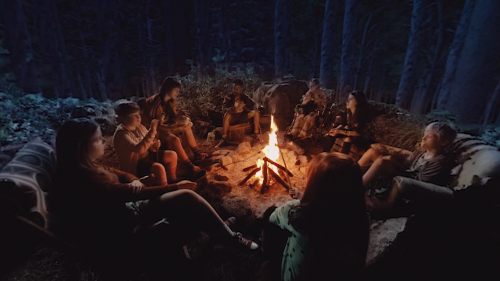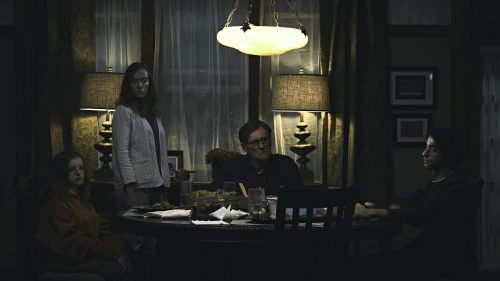The Overlook Film Festival Review: BOYS IN THE TREES
Writer/director Nicholas Verso’s Boys in the Trees is not a film that’s easy to categorize. The movie wraps itself in a heavy cloak of horror – utilizing ghosts, goblins, werewolves and all of the other usual suspects to be found in any standard supernatural line-up. Underneath the darkness, though, lies an emotionally poignant tale of growing up and friendships lost, itself its own version of panic. The film is an adventure into fear, albeit one with the beating, emotionally vulnerable heart of a Rodman Philbrick YA novel. Its visually rich look perfectly complements the film’s self-inflicted vulnerability. Boys in the Trees is a shaggy, seemingly highly personal coming-of-age story entangled with the rich mythology of Halloween. Stumbles and missteps included, the film is a wonderful feature debut from a filmmaker who is sure to be somebody to watch very closely.
Toby Wallace stars as Corey, a young man on the cusp of graduating high school in 1997 Australia. He dreams of moving to New York City to study photography but finds himself unable to escape the gravitational pull his best mate Jango (Justin Holborow) has on him. Corey and Jango are part of a pack, a group of teenage hellraisers who spend their time skateboarding, dipping into Corey’s father’s liquor cabinet and terrorizing Jonah, the school’s resident runt. As much as Corey might want to break free and follow his dreams, Jango keeps pulling him back with his promises of drugs, women and mischief.
Halloween night finds Corey and his pack dressed in costumes perfectly suiting their cruel plans. They vandalize homes, do a big of gay-bashing and lust after their female schoolmates while disrupting the peace and solitude of the local cemetery. Through this haze of juvenile delinquency, Corey starts to show signs of regret, of growing up. These morsels of maturity come to a head when he runs into Jonah, the victim of much of the pack’s cruelty. Jonah and Corey find themselves walking alone through the warm Halloween night, reminiscing of a long time ago, in a previous life, when the two were childhood friends and would spend their afternoons trying to scare each other. As they journey through the woods, headed home, old habits rear back up and Jonah begins telling Corey scary stories – teasing him with tales of dread, each rich in symbolism. Fantasy-tinged campfire stories about child abductors, haunted houses and werewolves explore the fear of being left behind during puberty, the fear of giving up on one’s dreams and the fear of charging hormones. As Jonah and Corey walk through the night, the film becomes an anthology of sorts – where the stories all serve as windows into the very real emotional struggles Corey finds himself in.
Boys in the Trees looks amazing. Verso and his production team have created a film where dark-tinged terrors flirt at the edges of mid-‘90s suburbia. Much of the film is perfectly drenched in the mundane banality that Corey so desperately wishes to escape from but, clawing at the edges of the frame, is the dark fantasy world that he and Jonah once spent so much time enveloping themselves in as children. The fantasy is highly-stylized, playful in the way a child’s make-believe world would suggest. The unease of seeing this playful horror invade and corrupt the real world, though, is highly effective.
Clearly inspired by Ray Bradbury’s The Halloween Tree, Verso’s Boys in the Trees draws upon an assortment of cultural inspirations and visual motifs. From the heavily stylized dialogue – rich in wordplay – to the patchwork menagerie of terrors – both real and imaginary – the teenagers encounter, the film is a loving tribute to the scary stories a generation grew up telling each other. The film’s crisp camera work only serves to give everything the slightly larger than life fantastical edge that comes with being a wide-eyed child. Boys in the Trees is not willing to be pinned down at any one particular point in time. It tackles highly adult themes and teenage drama but then takes a break for a wonderfully choreographed montage of mischief set to a Rammstein song. A scene sees two teenagers stumble upon a tree that is a literal representation of their shared childhood – its branches laden with lightsabers, teddy bears and much-needed emotional catharsis. It’s a film that embraces both childhood and growing up – a film that realizes how close the journey from birth and death can be.
It’s also just a flat-out cool movie. Maybe it’s my ‘90s nostalgia talking but any film that features a character stumbling onto a heavily stylized Day of the Dead memorial service where the film’s living embodiment of death, played by an elderly aboriginal actor, is singing Live’s Lightning Crashes is worth attention in my book.
The film is a bit shaggy, repeating some of the story beats a time too many and elements of the film’s emotional journey can come off as a bit too trite and on-the-nose but, as part of the larger package, I found these elements endearing. The film feels like the work of an artist who wanted to cram as much of their self-identity and influences into their debut film as possible, perhaps not knowing if there would be a second chance. Well, I sure hope Verso gets another chance to tell audiences a story because his film, while flawed, is a beautiful and emotionally rich horror film so blissfully unlike anything else on the proverbial video shelves. If you spend the year looking forward to Halloween and aren’t afraid of a little emotional rawness in your horror films, Boys in the Trees is an experience that must not be missed.



